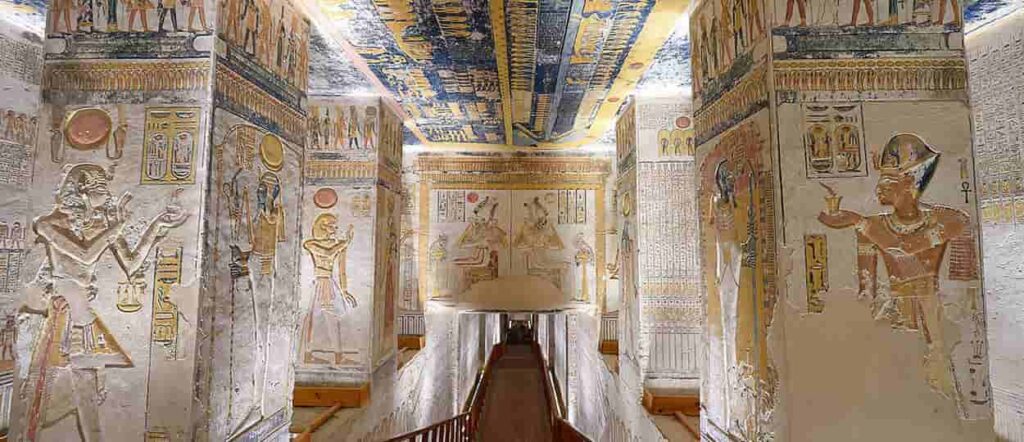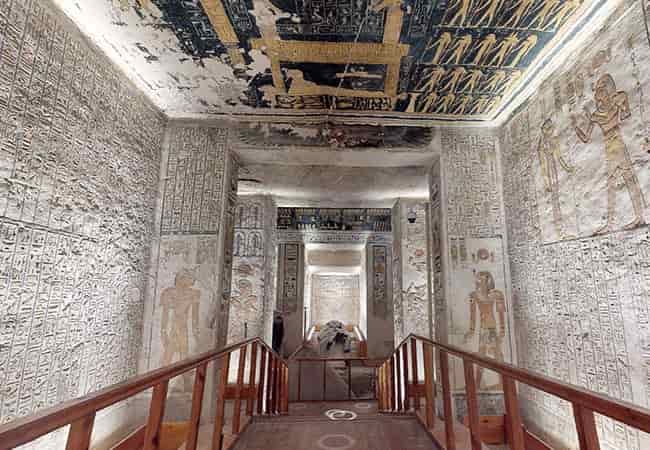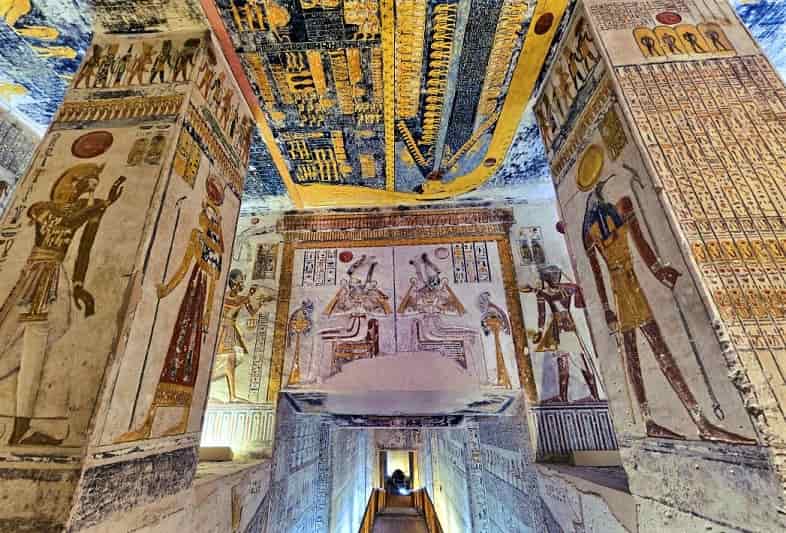KV9 is an Egyptian tomb in the so-called Valley of the Kings, located on the west bank of the Nile, at the height of the modern city of Luxor. It is one of the few tombs in the valley that was used by two pharaohs: Ramses V and Ramses VI, both belonging to the mid- 20th dynasty.
Ramses V and Ramses VI
The fourth king of the 20th dynasty, crowned with the name Usermaatre Sekheperenre Ramesses V, and usually known as Ramses V, is little known, and in his barely four years of reign (from 1147 to 1143 BC. , roughly) did not do anything worthy of renown.
Those were empty years, in which Egypt drifted adrift and the situation continued to worsen. The country had long since lost its empire, and poverty coupled with droughts and famine were destroying the place. The division of the country and the lack of will of the pharaohs only made things worse.
When Ramses V joined the list of deceased kings, without pain or glory, he was succeeded by his uncle, one of the youngest sons of the great Ramses III. Called Ramesses VI Nebmaatre-Meryamun, the new Ramses VI ruled seven more years, in which he played the same null role as his predecessor on the throne.
However, the determination of this pharaoh to declare his origin and to supplant the previous kings in numerous monuments is surprising. He would even usurp the tomb originally destined for Ramses V, as can be seen in this article.

KV9 or the tomb of Ramses VI
KV9 is located in a privileged place, very close to the central part of the Valley of the Kings, in a place where the rock is excellent and the density of tombs increases.
It is even practically on the same vertical as the famous KV62 , the tomb of Tutankhamun. Its entrance is immediately north of that of KV10 and is arranged almost parallel to, but further south, KV9 is located in a privileged place, very close to the central part of the Valley of the Kings, in a place where the rock is excellent and the density of tombs increases.
It is even practically on the same vertical as the famous KV62 , the tomb of Tutankhamun. Its entrance is immediately north of that of KV10 and is arranged almost parallel to, but further south, than KV8.
The design of the tomb is very complete, and it is one of the last tombs in the Valley completely finished, and also with an excellent result.
The profile of the place is very simple, with a total absence of attached chambers and the straight axis that all the tombs after the reign of Ramses II present.
The set is that of a tomb without great architectural pretensions, which could be finished without great problems thanks to the fact that it was started by the previous pharaoh, without great haste.

KV9 or the tomb of Ramses VI: Decoration
The tomb of Ramses VI can boast of being one of the best preserved within the Valley of the Kings. Despite having suffered some flood, the state of its paintings is good, and the frescoes and the structure of the place itself have not been seriously damaged.
The decorative program is somewhat different from that used by previous kings and includes for the first time the latest New Kingdom funerary text on its walls: the Book of Earth.
In addition, there is a particular preponderance of the god Ra against the one who usually monopolizes more scenes on these occasions, Osiris.
Excavation
Of all the tombs of the Valley opened in ancient times, KV9 is clearly the most visited and the one that aroused the greatest interest among travelers, coming to be baptized as the “Tomb of Memnon”, believing that the legendary king son of the goddess Eos.
Thus, it is not surprising that no very arduous excavation has been carried out, since the site was practically clear. However, we know that in 1888 Georges Daressy worked in the place and found some small fragments of the grave goods, vessels or coins belonging to the Greco-Roman tourists.
As mentioned above, the tomb is in an enviable state of preservation, with only a few flood damage down to the pillar chamber, and the paintings have not been lost as much as in other tombs.
Upon entering the burial chamber, one could see the outer red granite sarcophagus belonging to Ramses VI, and inside another one made of green conglomerate, whose mask is now exhibited in the British Museum in London. There is no trace of the burial of Ramses V.

The royal mummies
The first question – and perhaps the most obvious – is to know who or who were the definitive occupants of KV9.
Although it is true that the tomb was built and partially decorated by and for Ramses V, death surprised him before seeing the work done, and Ramses VI took advantage of the situation and appropriated the place. Now, was he buried alone or with his predecessor?
There are no remains that indicate the presence of Ramses V in KV9, nor does it seem that there was space for two large sarcophagi, which could indicate that the pharaoh was buried in another place yet to be determined and that Ramses VI would occupy the tomb at ease, which was not originally intended for him.
The limited knowledge we have of their reigns makes it impossible to know for sure if there were family disputes that caused Ramses VI to annul the memory of his predecessor or was simply an opportunist.
It is unlikely that the memory of Ramses V was haunted, since there is still some representation of him in the tomb itself.
Be that as it may, and thanks to the foresight of the priest-kings of the Twenty-first Dynasty, the mummies of Ramses V and VI have survived until today, both found in the hiding place of KV35, the tomb of Amenhotep II.
While the mummy of Ramses V is in an enviable state of preservation, the latter has seemed to suffer greatly at the hands of thieves and during its transfer.
The study of the mummy of Ramses V certifies that the pharaoh died around the age of thirty-five. The analysis of the skin (with the naked eye the numerous vesicles on the face, neck and arms, which are its usual marks), indicates that he died of smallpox, being the first documented case of this disease.
As if this were not enough, the pharaoh suffered from an inguinal hernia and what is worse, a hole has been found in his head that seems to have been made shortly before he died.
A murder or a trepanation to ease the pain of the unfortunate king? Nothing is clear, but carefully analyzing the mummy, up to three possible causes of his death can be found.
As for Ramses VI, his body is much more punished. The right forearm and wrist are torn. Hip bones were found at neck level and, as if this disorder were not enough, an arm of Seti II and the hand of a woman were also found among the bandages.
To be sure, the hasty priests, in their task of wrapping the mummies, did not realize that one of them was taking part of their select neighbors.
At the time of his death, the deceased appeared to be around forty to fifty years old, but the mummy does not leave too clear data on the cause of death. A hole has also been found in the skull of Ramses VI, but this was made post-mortem by thieves in search of valuable amulets.






